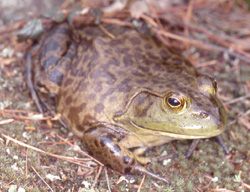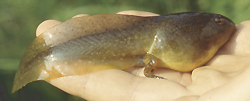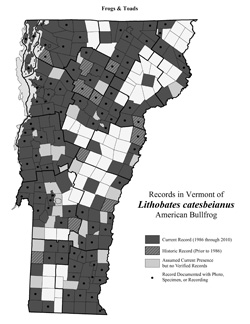Lithobates catesbeianus
American Bullfrog
Identification
The Bullfrog is one of the three green-faced frogs in Vermont (the others are the Mink Frog and the Green Frog). The American Bullfrog is our largest frog and can reach 7 inches long. It has a green and brown mottled body with dark stripes across its legs. The Bullfrog does not have dorsolateral ridges, but it does have a ridge that starts at the eye and goes around the eardrum (tympana) and down. Like the Green Frog, the throat of the breeding male is yellow.
The Bullfrog’s call is a deep, low “jum-a-rum”. It may be heard from May through August on warm nights, peaking at the start of July.
Similar to the Green Frog, the Bullfrog’s eggs form a film on the surface of the water, but both the eggs and the masses of the Bullfrog are larger. The American Bullfrog remains a tadpole through one or two winters.
Range/Habitat
They are generally found in or near large permanant bodies of water with emergent vegetation along the shoreline. They are locally common in the Lake Champlain Basin and the Connecticut River Valley.
Status
The American Bullfrog has a state natural heritage rank of S5 (common). Please report sightings of this species in Vermont if you have not reported them within the last five years from a given location. Any natural history observations (feeding, migrations, road crossing areas, early or late season appearance, abnormalities, etc.) are appreciated. Photographs are always helpful, particularly if your report is the first report of this species from a town.
More Info
All the Vermont species listed in the Rana genus were reclassified into the Lithobates genus in 2007. The Bullfrog also changed its species name from catebeiana to catebeianus
- Lithobates catesbeiana at Animal Diversity website
- Rana catesbeiana at Amphibiaweb
- Lithobates catesbeianus at the CARCNET website
- Rana catesbeiana at the Yale Peabody Museum website
- Listen to its call
at Animal Diversity (.aiff format)
at Amphibia Web (several calls / formats)
at Frog Quiz (QuickTime format)
at CARCNET (.wav format)
or at Yale Peabody Museum (.wav format)
Species summary written by Kaile Burgess.



